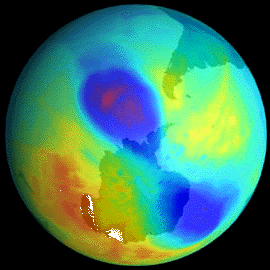
School
of
Chemistry
Effects on LifeDepending on it's position in the atmosphere, ozone can either protect or harm life on Earth. Tropospheric ozone is a harmful pollutant that causes damage to lung tissue and plants. Photochemical smog is produced when relatively high levels of ground-level ozone are produced as a result of the light-induced reaction of pollutants. Ozone pollution originating in urban areas can extend into rural areas hundreds of miles downwind. Most of the atmospheric ozone is found in the stratosphere, where it acts as a shield, absorbing UV light from the sun. A reduction in stratospheric ozone concentration would result in an increased amount of UV-B radiation penetrating to the Earth's surface. Exposure to UV-B causes tanning and sunburn in human skin, and overexposure can lead to skin cancer. Increasing amounts of UV-B may also adversely affect the human immune system and the growth of some plants and animals. These effects arise because UV-B can be absorbed by DNA molecules, which then undergo damaging reactions. |

 |
 |
 |
 |
 |
 |

